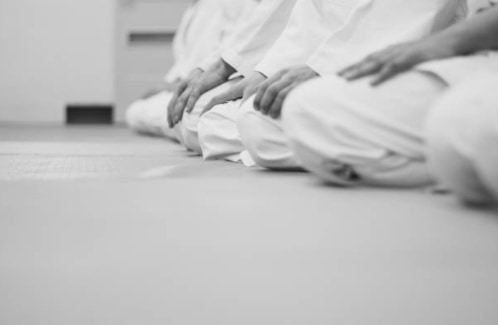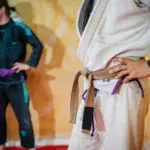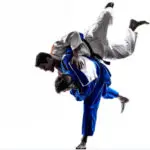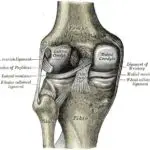Getting to fight is never something you should hope for, but there are still more ways than can be counted for fighting effectively. Brazilian Jiu-Jitsu has quickly been growing in popularity around the world, while Japanese Jiu-Jitsu has been practiced for centuries. Knowing what the difference is between the two could very well save you hours of headaches.
The difference between Brazilian Jiu-Jitsu and Japanese Jiu-Jitsu is the focus given to grappling used in Brazilian Jiu-Jitsu. Japanese Jiu-Jitsu has several fighting styles incorporated and uses Kata’s, which lends itself much better to large scale battle tactics used in ancient wars.

Getting your mind and body ready for any kind of Jiu-Jitsu is important, here’s everything you need to know!
What’s the Difference Between Japanese Jiu-Jitsu and Brazilian Jiu-Jitsu?
There is one glaring difference that even novice practitioners of Jiu-Jitsu will notice between the two Jitsu’s. It is this difference that drives the two into quite different communities, with many people looking to go towards Brazilian Jiu-Jitsu because they want to learn self-defense, while Japanese Jiu-Jitsu practices slower movements and calmness.
This has led to Brazilian Jiu-Jitsu with its fast movement, grappling techniques, and rolling sessions (which is like sparring). Since it can be practiced in a live setting it is used in some armies and police academies. Further, it has become favored in sports such as MMA for being a quick and effective way to force someone into tapping (giving up) and allowing you to win the fight.
While Japanese Jiu-Jitsu tournaments can be quite aggressive, martial art requires that you learn how to throw people, grapple them, and defend yourself in a larger variety of styles. When practicing Japanese Jiu-Jitsu many people have found that it is calming and can lead many people to find peace while learning how to avoid confrontations head-on.
One complaint against Japanese Jiu-Jitsu is that some places still do not incorporate live rounds. Controlled environments where the practitioner cannot test their skills in a live match can be detrimental to incorporating the techniques in a real self-defense scenario.
This one difference has led to the two styles finding favor in different groups, with Japanese Jiu-Jitsu usually favoring older people in the western world.
What Is Japanese Jiu-Jitsu?
Japanese Jiu-Jitsu is one of the oldest martial arts in the world, created to help the samurai fight. Many of the techniques assume that you will have a weapon of some kind on you and that you would be willing to either entirely disable or incapacitate your opponent. With a keen focus on overcoming and winning a fight with as few moves as possible.
Many practitioners are taught early on that the art of Japanese Jiu-Jitsu is not meant for someone who goes looking for a fight. Most of the techniques instead focused on defending oneself from another attacker. This allows the practitioner to disarm someone, and pin them without getting into harm’s way.
Japanese Jiu-Jitsu has also been seen as the originator of most martial arts that are popular today, with many masters of the art moving on toe create their fighting styles. Everything from Taekwondo to Kendo has its roots in Japanese Jiu-Jitsu.
What Is Brazilian Jiu-Jitsu?
Unlike Japanese Jiu-Jitsu, Brazilian Jiu-Jitsu is a much younger form of martial arts and has its focus completely set on one part of Jiu-Jitsu. The art of grappling with your opponent to disarm and pin them as quickly as possible. This is one of the reasons it has become such a popular martial art to learn for sports.
The movements of Brazilian Jiu-Jitsu all require that react and be fast, using your opponent’s weight against them. This then allows you to pin them in a lock and either cause a large amount of damage or force them to submit to you if you are doing it as a sport.
As the years have passed many practitioners of Brazilian Jiu-Jitsu have moved on to other martial arts, this is owing to the strain that martial art puts on the body. To fully practice Brazilian Jiu-Jitsu, you have to be fit and capable of movement for either short bursts of time or long hours on end.
Where Are The Two Practiced?
These two martial arts are practiced in quite different ways around the world, with each finding favor and traditions in some of the most humbling ways. While Brazilian Jiu-Jitsu has fast become the more well-known martial arts it is not the most widely practiced among martial artists.
Understanding where the two are being used and how is a vital part of knowing which one is the best for you and the needs you may have from it.
Brazilian Jiu-Jitsu
Known for being quick to pin someone and forcing the fight to the ground Brazilian Jiu-Jitsu become prominent in 1993 when the winner of the first three UFC championships was Royce Gracie. His family was one of the founding members of Brazilian Jiu-Jitsu and his victories quickly made the effectiveness of grappling prominent in the sport.
Japanese Jiu-Jitsu
Pinpointing where exactly Japanese Jiu-Jitsu is being used is quite hard as most martial arts in the world use some part of it. The first sports version of Japanese Jiu-Jitsu was Kendo, which has now become an Olympic sport. Further, many competitions around the world use Kata as a competition as well.
Jiu-Jitsu as a whole is still regularly practiced in Japan and requires that the practitioner learns several styles at once. Few people can master it owing to the years of practice and training required.
How Old Is Jiu-Jitsu?
The exact source of Jiu-Jitsu is hard to pinpoint, with the first written record of the martial art being from 710. In this early form, it was a combination of various battlefield martial arts, however, by the year 1130 there was a definite form to Jiu-Jitsu, and by the year 1532, the style had cemented itself.
The early styles all used forms and techniques that focused on weapons that could be used on foot or the back of a horse. Allowing practitioners to be much more effective no matter where they were fighting on the battlefield. One of the most interesting things about Jiu-Jitsu was the versatility it afforded to those using it.
Allowing most people to adapt to the size and fighting style of their opponent, overcoming the danger of not being aware of how to counter easily and fluently. By constantly adding new moves and refining old ones Jiu-Jitsu eventually became watered down and practiced by more common people.
Once it was no longer used exclusively for war many of the fighting styles and techniques were made much less effective. With some moves changes specifically to cause less damage to the opponent that may have been fought against.
Conclusion
There are many styles of Jiu-Jitsu, with Japanese Jiu-Jitsu being the original; however, this does not mean that Brazilian Jiu-Jitsu is any less effective. Knowing the two styles and how to apply them when needed can be the difference between being lost in a fight or overcoming any challenge no matter how outmatched you may look.
Japanese Jiu-Jitsu follows a more traditional martial art route while Brazilian Jiu-Jitsu has a modern approach. BJJ has evolved to be used either in sport BJJ or supplementary training to improve a fighter’s ground game.


